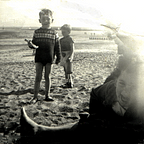Down by the Salley Gardens
Yeats hears ‘three lines imperfectly remembered by an old peasant woman’
An Old Song Re-Sung, from three lines imperfectly remembered by an old peasant woman in Ballisodare, Sligo, who often sings them to herself.” W.B Yeats
Which old song though, Willie? Your opening verse:
Down by the salley gardens my love and I did meet;
She passed the salley gardens with little snow-white feet.
She bid me take love easy, as the leaves grow on the tree;
But I, being young and foolish, with her would not agree.
seems a mite similar to this one from The Rambling Boys of Pleasure:
Down by yon flowery garden my love and I we first did meet.
I took her in my arms and to her I gave kisses sweet.
She bade me take life easy just as the leaves fall from the tree.
But I being young and foolish, with my darling did not agree:
What are the Salley Gardens? Where are they?
Yeats acknowledge his debt to Anon in the original 1889 title An Old Song Re-Sung. But alas there would be no royalties for thatched cottage upgrades. The Rambling Boys of Pleasure was centuries out of copyright — Trad and Anon always miss out on payday.
Crucially, the word Salley does not feature in The Rambling Boys of Pleasure. Nor does it it appear to be connected to Sally — as a first name. This would have stood out as Anglo-Irish. Irish Catholics chose from a limited menu of saints’ names. There is no Saint Sally to my knowledge.
Instead the derivation seems to be linked to the cultivation of willow trees for thatching — perhaps from sallow in standard English or saileach in Irish. Ballisodar, where Yeats heard the woman singing, is named after its river.
The use of ‘gardens’ is also telling. My first mental image was BBC Costume drama — with pale maidens twiddling parasols in shady nooks. The reality would have been closer to that shown in this family photo, taken in a similar area of the west of Ireland in the early 1930s. For my mother and grandfather, the ‘garden’ was a vegetable patch outside the three (tiny) room cottage — the plural form being an English thing — Kew and so on.
Hughes setting
Like the The Lake Isle of Innisfree (1888) — written by the Thames in Chiswick, by the way — Down by the Salley Gardens became emblematic of the Celtic Revival. In 1909 Herbert Hughes, an influential composer and folk song collector set it to another old tune: The Maids of Mourne Shore.
At the turn of the century, Dublin had a thriving classical music scene (features in Dubliners and Ulysses), with crossover from the local literary world. The Maids of the Mourne Shore had been collected by George Petrie in 1834 and so was probably familiar to Joyce and Yeats, even if it wasn’t on the old peasant woman’s setlist.
Came with a lyric, too, though not one featuring willow trees:
Ye hills and dales and flowery vales that lie around Mourne shore,
Ye winds that blow over Martin’s Hills will I ever hear you more;
Where the primrose grows and the violet blows and the sporting trout there plays,
With line and hook delight I took to spend my youthful days.
‘Sporting trout’? You won’t find anything so clunky in Yeats. Down by the Salley Gardens may be romanticised vision of rural courting but it would prove a sublime match for The Maids of Mourne Shore
What did the singing peasant think of the new words and music combo? We’ll never know. She had long passed on to another pasture.
Interpretations
The Hughes setting became the standard, entering the classical repertoire with variations by Rebecca Clarke, John Ireland, Britten, Gurney and other luminaries. Amongst the most celebrated interpretations are those by Peter Pears (with piano accompaniment by Britten) the 1941 recording by John McCormack and that by Kathleen Ferrier in 1949. Counter tenor Alfred Deller’s more baroque variation has also been influential.
In 1965 Marianne Faithful returned the song to its folk origins on her Come My Way album, while an army of traditional Irish musicians have recorded it in various styles since.
All from a woman brightening up her day by singing within earshot of long, skinny gossoon from one of those big houses.
